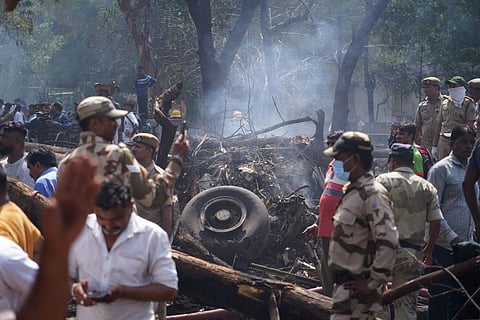Air India plane crash: Junior pilot asked captain why he turned off fuel switches
The other pilot had denied turning off the switches, according to the AAIB report

A cockpit voice recording of doomed Air India flight 171 indicates the younger co-pilot asked his more experienced colleague why he turned off the plane’s fuel-supply switches, according to people familiar with the matter.
The information, from people who asked not to be identified because they’re not authorized to speak publicly, reveals for the first time who said what in the flight deck. The exchange was first mentioned in last week’s preliminary report from India’s Aircraft Accident Investigation Bureau probing the June 12 crash in Ahmedabad, but without identifying the speakers.
What does the report say?
The report had shown two fuel switches in the cockpit were moved to a cut-off position, causing the Boeing Co. 787 Dreamliner to lose lift and crash 32 seconds after takeoff. The other pilot had denied turning off the switches, according to the AAIB, which had extracted data from the cockpit voice recorder.
Aviation experts had speculated that it was first officer Clive Kunder who had posed the question to captain Sumeet Sabharwal given Kunder was the pilot flying and would have had his hands full — one on the yoke commanding the widebody into the skies, and the other on the throttle controlling the aircraft’s speed. The Wall Street Journal previously reported who said what in the exchange.
The initial investigation showed that the fuel-control switches were turned off immediately after the plane departed. While the move was reversed about 10 seconds later, it was too late to avert the June 12 crash that killed 260 people on board the plane and on the ground.
Earlier, US Federal Aviation Administration (FAA) formally declared that fuel control switches used in Boeing aircraft, including the 787 Dreamliner, do not pose a safety risk. The FAA clarified that although a 2018 bulletin had urged carriers to inspect locking mechanisms on fuel switches due to reports of them being installed with the locking feature disengaged, this recommendation was advisory and not mandatory.
Unanswered questions
How and why the switches came to be turned off — cutting the flow of fuel to the engines — are now the key lines of inquiry for investigators. Officials are probing whether it could be the result of a failure of the plane’s systems or human error.
And while the new details add fresh perspective on the confusion in the cockpit during the 32 seconds between takeoff and crash, investigators still haven’t drawn any definitive conclusions.
The cockpit recording could be even more revelatory, according to Michael Daniel, a retired Federal Aviation Administration inspector and accident investigator.
“There are multiple microphones around the cockpit including their headsets,” said Daniel.
The mic positions means it’s possible that it captured and discerned not just the sound of the fuel switches being turned off, but the direction from which it came in the cockpit — offering investigators definitive information as to who cut off fuel supply to the planes engines, he said.
Earlier this week, India’s civil aviation authority ordered an inspection of cockpit fuel switches on Boeing 737 and 787 aircraft operating in the country in an effort to ascertain whether the crash was caused by equipment failure.
Role of pilots
Aviation psychologists and medical specialists are also involved in the investigation — a typical practice across the aviation industry — to probe the role of the pilots in the crash.
The first officer expressed surprise that the fuel switches were off and then panicked, the Wall Street Journal reported, citing people familiar with US officials’ early assessment of evidence. The captain seemed to remain calm, according to the report. The Airline Pilots’ Association of India has pushed back on human action as the cause.
The Indian Commercial Pilots Association (ICPA) said it was "deeply disturbed by speculative narratives... particularly the reckless and unfounded insinuation of pilot suicide".
"There is absolutely no basis for such a claim at this stage," it said in a statement on Sunday, adding, "it is deeply insensitive to the individuals and families involved".
The AAIB didn’t immediately respond to requests for comment sent outside normal business hours. The US National Transportation Safety Board, which is assisting on the investigation, referred questions to the Indian authorities. Boeing also referred questions to the AAIB. Air India and GE Aerospace, which manufactured the engines, declined to comment.
Air India Chief Executive Officer Campbell Wilson said in a memo to employees on Monday, viewed by Bloomberg News, that the report identified no cause and didn’t make any recommendations. “I urge everyone to avoid drawing premature conclusions as the investigation is far from over,” he said.
What are fuel switches?
Fuel control switches regulate the flow of fuel to an aircraft’s engines — a critical function for flight safety and engine performance. These switches are used to:
Start or shut down the engines while on the ground
Shut down an engine during emergencies, such as fire or system failure
Restart an engine mid-flight, if needed
According to aviation experts cited by Reuters, moving these switches to the CUTOFF position immediately halts the fuel supply, causing the engine to shut down. Due to the serious consequences of activation, the switches are designed to prevent accidental movement.
Where are they located?
In the Boeing 787 cockpit — including Air India’s GE-powered model — the fuel control switches are positioned directly below the thrust levers on the central console.
Their placement is standard across all 787s and is designed for quick access during critical procedures, while still requiring a deliberate pull-up action to operate, which helps prevent unintentional use.
With inputs from Bloomberg
Sign up for the Daily Briefing
Get the latest news and updates straight to your inbox



